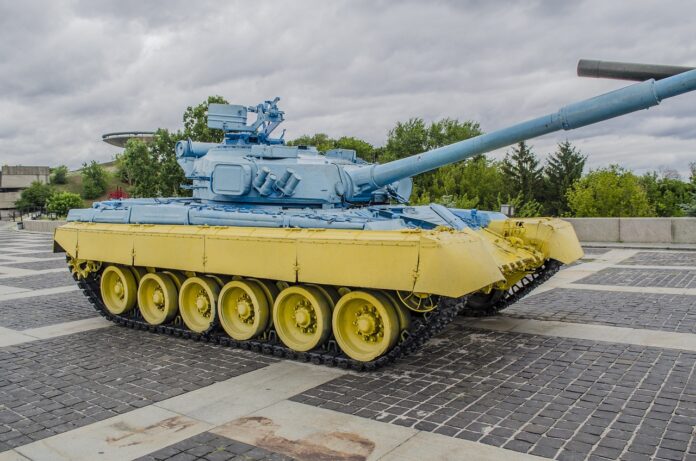Ukraine war: with stalemate on the battlefield Nato needs unity and commitment more than ever
By Kenton White, University of Reading
As the Ukrainian president, Volodymyr Zelensky, arrived in Washington earlier this month for talks aimed at securing further military aid, Republican congresswoman Marjorie Taylor Greene posted on X (formerly Twitter): “With Zelensky in town and Ukraine money running dry, why doesn’t anyone in Washington talk about a peace treaty with Russia?? A deal with Putin promising he will not continue any further invasions. Answer: Washington wants war, not peace. Isn’t that awful?! I’m still a NO.”
Greene and her hard-right Republican colleagues have been attempting to leverage domestic politics to influence the US response to an international crisis without truly understanding the consequences. What is not being made clear by those who argue an isolationist “America first” line to a receptive conservative audience is that a significant proportion of the aid given to Ukraine, possibly as much as 90%, stays within the US. It is used to buy American-made armaments and other goods.
But the geopolitical repercussions are very clear and very significant. If the US stops providing Ukraine with military aid, it will lose the war and leave Putin with the message that it has everything to gain from military aggression.
Greene and her ilk clearly haven’t grasped the coldblooded ease with which Putin has broken both Russia’s treaty obligations and international law with the illegal invasion of Ukraine. It demonstrates a clear lack of understanding of the realities of relations with Russia.
But it’s an ominous sign for Ukraine that a growing number of its allies within Nato are having these internal discussions over supplying Kyiv with military aid. It goes to the heart of Nato’s core task of crisis management and cooperative security, as described in its 2022 Strategic Concept, which identifies Russia’s invasion of Ukraine as the key crisis facing the alliance.
The key question now is whether Nato can continue to provide a coherent and coordinated response to Russia’s aggression.
Nato capabilities
The war has put enormous pressure on Nato’s weapons manufacturing capability. Prior to the invasion of Ukraine, Nato strategy was to produce and stockpile a limited supply of weapons and ammunition to fight small or “come-as-you-are” wars – a term often used to describe the sort of conflict that doesn’t require a shift to a wartime economy.
The question now is whether the west can ramp up its manufacturing capacity to fight what is in essence a proxy war. To give just one example, the number of Javelin missiles sent by the US to Ukraine from the end of February 2022 to August 2022 represented seven years of regular production.
Perhaps Nato could learn from the experience of South Korea, which for the whole of its existence has been familiar with border tensions and the need to maintain a strong military capability.
For decades it has stockpiled weapons and ammunition and has shipped more 155mm shells to Ukraine than all of Kyiv’s European allies combined. Seoul now has one of the world’s biggest stockpiles of weapons and ammunition. Perhaps Nato needs to do likewise.
But the main problem that this conflict presents to Nato is that on the one hand it is willing and ready to share its military doctrine with Ukraine, but on the other it has not been able – or willing, in some cases – to provide the wherewithal for Ukraine to fight the war accordingly.
Nato’s combined arms doctrine relies on the coordination of land and air power. Without one, the other will not provide the results demanded. And, as yet, Ukraine cannot control the skies above the battlefield as it has insufficient fighter jets and trained pilots.
The third element of a combined military doctrine is sea power, which is where Ukraine has enjoyed a degree of success, denying Russia control of the northwestern Black Sea and launching several attacks on Russia’s Black Sea fleet at Sevastopol, which has compelled Russia to move its naval assets to safer ports further afield.
Britain, the Netherlands and Norway have agreed to send mine clearing ships to Ukraine to help secure shipping lanes against Russian attempts to set a blockade.
Significantly, access to the Black Sea through the Dardanelles is controlled by Turkey, a Nato member, and transit of warships of belligerent nations can be refused. Turkey has denied at least one Russian request to transit warships through the straits, but it cannot refuse access to Russian ships which are based in the Black Sea.
Playing politics
The key concern, though, is political. In recent months – and certainly since the conflict in Gaza exploded into life on October 7 – there have been signs that support for Ukraine’s war effort from western countries may have a limit.
In the US, Republican senators blocked the passage of an aid bill which would have delivered up to US$60 billion (£47 billion) for Ukraine as well as funds for Israel and aid for Gaza. Meanwhile Hungary recently vetoed a EU aid package of a further €50 billion (£43 billion).
Both the EU and the Biden administration in the US are confident that they will eventually get their funding bills through, but voices calling for Ukraine to seek a ceasefire with a possibility of a territorial settlement with Russia have grown larger since it became clear that Kyiv’s summer counter-offensive would not be the success that had been hoped for.
Putin signalled in his annual press conference recently that Russia’s war aims had not changed, saying: “There will be peace when we achieve our goals. They haven’t changed. Denazification of Ukraine, the demilitarisation of Ukraine.”
Nato needs to be equally clear about what it wants the outcome of this conflict to look like.![]()
Kenton White, Lecturer in Strategic Studies and International Relations, University of Reading
This article is republished from The Conversation under a Creative Commons license. Read the original article.



